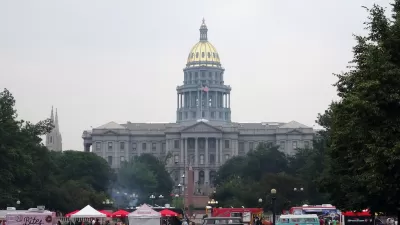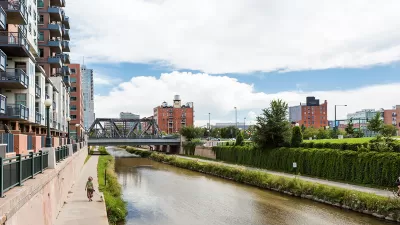A $15 million investment has so far failed to cleanse Denver's downtown park - part of the city's first National Historic Landmark - of rampant drug use and crime. What more can the city do to speed up change?
"Six years ago, Denver went all out to jump-start a Civic Center renaissance, envisioning a manicured green space busy with ordinary people enjoying strolls, brown-bag lunches, after-school soccer games and evening concerts, instead of the transients, hookers and drug dealers who infused the downtown park with a sinister vibe. But despite more than $15 million spent to reclaim the park, the perception of danger has not disappeared," writes Colleen O'Connor.
Although fitness classes, office workers, and food trucks populate the park during the day, fights, shootings, and rampant drug use are also commonplace. But increased policing alone won't solve the park's enduring problems, notes O'Connor.
"A Civic Center safety summit was convened June 3, with people including representatives from the mayor's office, Denver Environmental Health, Downtown Denver Partnership, the district attorney's office, Denver's Road Home and Denver Human Services," she reports. "The solution, they agreed, must be multifaceted — rooted in seven areas: social services; maintenance; programming of activities; infrastructure; legal enforcement and prosecution; resources; and community and political will."
"'The problems are not solved overnight,' said Charles Birnbaum, founder and president of the Cultural Landscape Foundation in Washington, D.C., citing such examples as Central Park in Manhattan and Prospect Park in Brooklyn. 'This is the story of American parks. Civic Center park hasn't had its renaissance yet.'"
FULL STORY: Crime and drugs bring renewed attention to Denver's Civic Center park

Alabama: Trump Terminates Settlements for Black Communities Harmed By Raw Sewage
Trump deemed the landmark civil rights agreement “illegal DEI and environmental justice policy.”

Planetizen Federal Action Tracker
A weekly monitor of how Trump’s orders and actions are impacting planners and planning in America.

The 120 Year Old Tiny Home Villages That Sheltered San Francisco’s Earthquake Refugees
More than a century ago, San Francisco mobilized to house thousands of residents displaced by the 1906 earthquake. Could their strategy offer a model for the present?

In Both Crashes and Crime, Public Transportation is Far Safer than Driving
Contrary to popular assumptions, public transportation has far lower crash and crime rates than automobile travel. For safer communities, improve and encourage transit travel.

Report: Zoning Reforms Should Complement Nashville’s Ambitious Transit Plan
Without reform, restrictive zoning codes will limit the impact of the city’s planned transit expansion and could exclude some of the residents who depend on transit the most.

Judge Orders Release of Frozen IRA, IIJA Funding
The decision is a victory for environmental groups who charged that freezing funds for critical infrastructure and disaster response programs caused “real and irreparable harm” to communities.
Urban Design for Planners 1: Software Tools
This six-course series explores essential urban design concepts using open source software and equips planners with the tools they need to participate fully in the urban design process.
Planning for Universal Design
Learn the tools for implementing Universal Design in planning regulations.
Clanton & Associates, Inc.
Jessamine County Fiscal Court
Institute for Housing and Urban Development Studies (IHS)
City of Grandview
Harvard GSD Executive Education
Toledo-Lucas County Plan Commissions
Salt Lake City
NYU Wagner Graduate School of Public Service




























